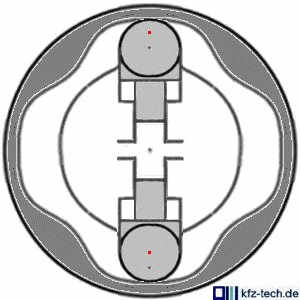|
|
Common Rail (3. generation)
| Development in the direction of a one- to four-piston pump |

In the meantime, the development trend of common rail is quite clear. It appears, all in all, that the stage shown in picture 2 is asserting itself. The cam-ring operated pistons (see picture 1) originate basically, from the
era of the radial pumps.
| The pump for smaller engines is driven by- and at the same speed as the engine |
At the latest, in the third generation of common rail, the increase in efficiency is noticable. The size of the storage should be about 1 cm³ per 100 cm³ of engine capacity. Thus, a pump with two pistons (see picture 3)
for a six-cylinder engine and with one piston for a four cylinder (see picture 4), could make sense. Have a look at the respective chain-drives of the pumps. They run at the same RPM as the crankshaft.
| Piezo technology instead of magnetic valve, indeed, the current-flow is turned around |
In the third generation the magnetic valve has dissapeared. Piezo actuators determine the procedures, in the most favourable case, the in-line technology, which means, in the injector shaft. Hereby, the individual
Piezo layers are grouped together to form ceramic tiles several of which are inserted into the injector casing. When being addressed, the closing pressure is also opened to the flow-back, however, the piezo is under
current-flow when closing and not when opening.
| 3rd generation with higher pressure and in-line-technology |
The Bosch 3rd generation common rail generates a pressure of approx. 1800 bar. These systems can be recognized by one- or two-piston high pressure pumps and the in-line Piezo injectors. They are called in-line
because the Piezo element is installed inside the the injector shaft. This construction method ensures that the component is very slender. It does however, require the use of a hydraulic coupler in the injector, so that
it's heating does not influence the injection volume. The injector can, through the Piezo element, inject up to 5 times, 2 pre-injections for steady running, one large main injection and up to 2 post-injections.
| Diesel fuel is important for the cooling and the lubrication |
An electric 'in-tank' pump supplies the fuel pump with fuel at a pressure of approx. 3 - 6 bar. Before the fuel is sent to the inlet valve of the high pressure pump, it passes through the pump itself and through the
dosage-valve, only then does it reach the inlet valve. This ensures the lubrication and cooling of the pump before it is injected. Should erroneously, petrol find it's way into this injection system, replacement will almost
certainly be necessary.
| The high- and the low pressure valves have different tasks |
In the pre-supply side, the high pressure regulation valve and the dosage-valve can divide the task of regulating the rail-pressure amongst themselves. During the warm-up phase the fuel should be heated relatively
quickly. The dosage-valve allows more fuel than is needed for the compressing to come through, this is then heated and the high pressure regulation valve sends the excess fuel to the flow-back. When the rail
pressure is high and the RPM constant, the rail pressure is controlled by both valves. Indeed, only the dosage-valve increases the effectivity of the high pressure pump.
| Various pressures after switching the engine off |
Depending on the manufacturer, the pressure in the rail when the engine has been switched off varies, e.g., in 1st, 2nd and 3rd generation equipment. Bosch in fact, leaves it open when the engine is not running, to
avoid, through a 'pressureless' state, any vapour-lock in the rail. Vapour bubbles can delay the re-starting of the engine when it's hot. 07/10
|
|